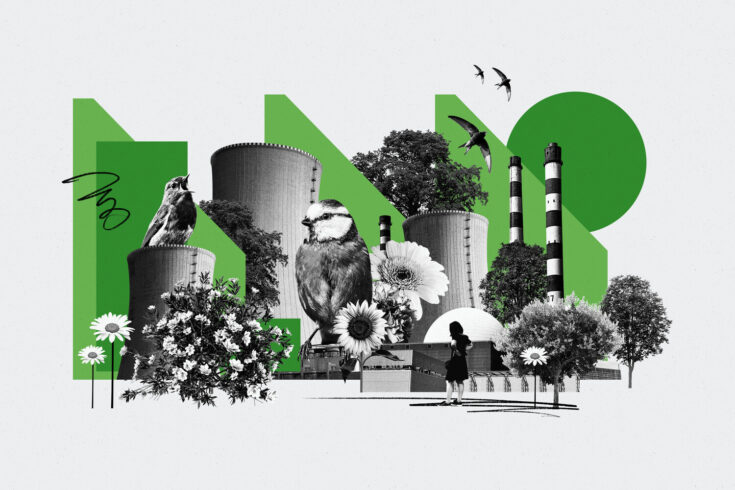Raised in South Yorkshire the proud son of a coal miner I joked about ‘panda rings’ around my father’s eyes bearing witness to the physicality and harshness of toiling miles underground.
The coal industry is now gone, as is my father, taken early because of damage digging fuel to power a nation.
Guided by my parents, I entered the nuclear industry, believing in the promise of a high-technology industry where engineering, computers and science mattered more than sweat and shovels.
I am now privileged to lead the Innovate UK team that manages the low-cost nuclear challenge on behalf of the government.
Delivering small nuclear power stations
Our main objective, working with our supplier Rolls-Royce SMR, is to deliver the design of a small modular power station and the assessment of that design by UK regulators.
The project is developing the design of a nuclear power station that can be predominantly manufactured in a factory and assembled on site.
This unique approach to nuclear power is intended to deliver scalable, repeatable and predictable assembly, which could ultimately mean you can effectively buy a low-carbon nuclear power station and be comfortable it will arrive on time.
Ambition is for 24GW of nuclear capacity
The importance of energy security and net zero needs no amplification. A series of government announcements have progressed understanding and debate, including the Energy White Paper, the 10 point plan for a green industrial revolution, the British energy security strategy and the recent net zero review.
The Climate Change Committee has predicted future UK demand for energy available to around 600 terrawatt hours (TWh) per year in 2050, compared to around 300 TWh in 2018.
This near doubling of need, the minimisation of fossil fuels and legal commitments to net zero have shaped government’s challenging ambition to have up to 24GW of nuclear generating capacity.
Nuclear has an unfair reputation
You often hear that ‘all nuclear is late and expensive’. This to some degree mischaracterises and unfairly labels nuclear new build as a particular case.
For much of their early life, traditional nuclear generation projects are large, complex, challenging construction projects, typically classified as mega-projects. There is much research and data that shows mega-projects (projects over around £2 billion) are nearly always over budget and late.
Many of the reasons for this are captured in the ‘Market framework for financing small nuclear’ independent report published by Department for Business, Energy and Industrial Strategy.
Size, complexity, uniqueness (physical and organisational) and unique builds separated over many years are common issues in mega-projects.
Traditional £20 billion nuclear projects are vulnerable to all of them, but small nuclear reactors can address size, complexity, uniqueness and frequency of build.
Small reactors can be cheap and quick
Small modular reactors are all typically projected to cost less than £2 billion. Precise costs vary but are predominately driven by the risks to investment and the cost of finance for a project.
All small modular reactors seek to deploy rapidly and consistently in a fleet approach where continuous improvement delivers accelerated learning. Project times are typically quoted in ranges from 4 to 7 years.
They all claim to be designed on principles of reducing complexity and replicating design to enable consistent manufacturing and construction process.
In the Rolls-Royce small modular reactor, more than 80% of all components and systems will be made and tested in offsite factories. This is a major innovation.
Factories can reduce costs by adopting high-value advanced manufacturing and real-time digital twinning and by applying artificial intelligence to design and product lifetimes.
Nuclear is green
I believe net zero needs nuclear. The science is unambiguous: nuclear is green.
The United Nations Economic Commission for Europe report ‘Carbon Neutrality in the UNECE Region: Integrated Life-cycle Assessment of Electricity Sources’ examined all electricity generating technologies. The results are clear. Nuclear is a safe and sustainable technology.
It has the lowest lifecycle greenhouse gas emissions of any electricity generating source, calculated in the range of 5.1 to 6.4g carbon dioxide equivalent for each kilowatt hour of electricity. And it has the lowest land footprint of any technology (1000 watts per square metre compared with 2 to 3 watts per square metre for wind and 100 watts per square metre for solar).
Nuclear can run continuously at a very high capacity and has the lowest lifecycle impacts on ecosystems of any technology. Its risk profile is similar to wind power and around 350 times safer than coal.
The industry has well proven techniques for safely dealing with the small levels of hazardous waste found in spent fuel. This skill and expertise has been developed over many decades and the UK is a world leader in this capability. Modern power plants minimise waste produced in this way and there are a number of programmes of research which are looking to use the related residual energy as power sources going forward.
UK is a world leader in nuclear power
The UK has history as a world leader in nearly all stages of the nuclear lifecycle from reactor design, fuel fabrication, and waste management to energy production.
Calder Hall Cumbria was the world’s first nuclear power station to produce electricity for domestic use. Construction began in 1953. It was the first of 8 small units to be built in just 5 years. This success was followed by 14 advanced gas-cooled reactors at 6 sites built between 1976 and 1988.
As I sit writing on a cold February day, the ageing advanced gas-cooled fleet is consistently generating 16% of the UK electricity while producing only 1.2% of total carbon emissions. However, these stations will be retired by 2030 and must be replaced.
I believe small modular reactors can be a vital part of the answer to the net zero mission. They offer a realistic possibility of predictable deployment, replication and falling costs.




